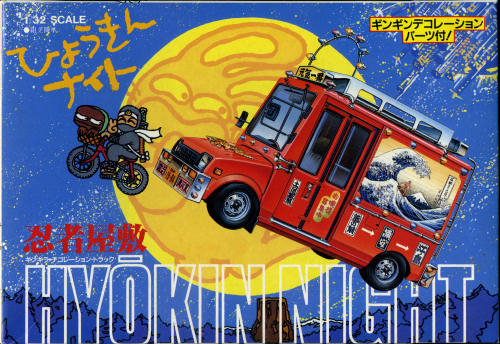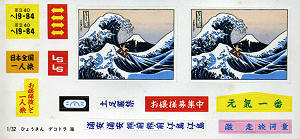
LS 1/32 Daihatsu Mira 'Hyokin Night'
| KIT #: | 2213 |
| PRICE: | $10.00 second hand |
| DECALS: | One option and they are stickers |
| REVIEWER: | Scott Van Aken |
| NOTES: | Curbside |

| HISTORY |
The Daihatsu Mira (also known as the Cuore, Domino, and more recently Charade), is a kei car-type vehicle built by the Japanese car maker Daihatsu. It comes with a variety of options and chassis variations, with the latest variant having four models: "Mira", "Mira AVY", "Mira Gino" and "Mira VAN". The Mira is the latest successor to the line of cars begun with the Daihatsu Fellow of 1966 and was originally introduced as the commercial version of the Cuore. Outside of Japan, the Mira has also been offered with an 850 cc engine. In Australia, the two-seater version was known as the Handivan and was later renamed as just Handi.
In July 1980, the Daihatsu Mira and Cuore arrived to replace the Daihatsu Max Cuore. A certain amount of confusion arises from the fact that this, the L55-series, was the first generation Daihatsu Mira but is considered the second generation of the Cuore. The second generation (L70) of the Mira/Cuore was introduced in 1985, and the third generation (L200) in 1990. The third generation of Mira also was identical in look to the 1986-1992 Daihatsu Leeza. The fourth generation (L500) was introduced in 1994 and was still based on the same chassis as the L200. October 1998 saw the fifth generation (L700) introduced, the sixth generation was introduced in 2002 (even though the Mira Gino (L700) remained in production until 2004), and in 2006 the seventh generation model was introduced.
The second generation (L70) Mira/Cuore appeared in August 1985. It had a longer wheelbase and a new generation of three-cylinder engines replacing the previous two-cylinder (AB) versions. Displacement of the new EB engines remained exactly the same, at 547 cc. For the export versions an 847 cc three-cylinder was developed, called ED-10. In September 1986 a special version for the Swiss market appeared, with a narrower bore version displacing 796 cc (called ED-10A). Unlike the fractionally larger standard version, this one suited the four tax horsepower category in certain cantons, while other cantons had prominent tax limits at 800 cc.
As for the domestic Japanese market versions, there
were commercial versions (Mira) sold alongside passenger car versions (Cuore).
The commercials had temporary rear seats which fold completely flat, and are
easily recognized by luggage rails in the rear side windows. As for the previous
generation, a version with switchable four-wheel drive was available for the
"Van" version (chassis code L71V). The engines were originally carburetted, and
either naturally aspirated or turbocharged (with intercooler). These offered
38 PS (28 kW) and 52 PS (38 kW) respectively. The turbo version was only
available as a Mira (three-door commercial), and was introduced two months after
the regular version. Transmissions were either four or five speed manuals, with
a two-speed automatic also available for the atmo
The L200 variant (1990–92) had two engine sizes: a three-cylinder 660 cc engine with 40–64 PS (29–47 kW) was available in Japan, while in Australia and other parts of the world a bigger-hearted variant with a 847 cc and either a four or a five-speed manual gearbox was used. The L500 Mira is the first kei car from Daihatsu which offered a four-cylinder 660 cc engine.
In January 1986, a five door "Van" (Mira) version was added. A "Walk-Through Van" version (and subject of this kit), using the regular bonnet combined with near square rear bodywork, appeared two months later.
| THE KIT |
 This
is obviously a special boxing. I have not a clue as to what Hyokin Night is or
means. My inquiry as to its meaning has gone unanswered and the web was not
particularly helpful. I can only assume it is some sort of celebration.
This
is obviously a special boxing. I have not a clue as to what Hyokin Night is or
means. My inquiry as to its meaning has gone unanswered and the web was not
particularly helpful. I can only assume it is some sort of celebration.
The kit itself falls along the line of all the LS kits in this series. It is a relatively simple kit with very little in the way of fiddly bits. No engine, a simple or rather non-existent suspension and minimal bits for the inside.
This kit is a bit different from the stock Mira. For one thing, it has a large sprue of gold plated plastic. It also has a rather large number of additional lights. There are lights on a frame over the top front of the cab, lights on the side of the bumpers, lights around the artwork on the side, lights everywhere. From the look of things, this one is outfitted more like the Jeepneys I used to see in the Philippines. Those were a mass of lights and bright paint work.
Another departure from many LS or Arii kits like this
is that this one has a friction drive. This assembly includes the rear axle and
one can only assume that the plastic wheels will be robust enough to hold up. A
one-piece body is included with large clear
 pieces. These
clear bits have equally large attachment sections, making it a very robust
construct and ensuring that one will not smear the windows with glue.
pieces. These
clear bits have equally large attachment sections, making it a very robust
construct and ensuring that one will not smear the windows with glue.
Instructions are fully in Japanese, but easy enough to decipher what goes where. Color information has the little Gunze paint numbers so if you are familiar with them, you should have no trouble when it comes to painting. The only somewhat disappointing part of the kit is the markings. These are not decals, but stickers. They are quite colorful and perhaps a clear coat will help to make them more durable.
| CONCLUSIONS |
So there you have it. Another weird and wonderful kit from the land of the rising sun. It is rare that we find fun things like this produced in the US, but in fad-crazy Japan, these are almost the norm.
| REFERENCES |
http://en.wikipedia.org/wiki/Daihatsu_Mira
December 2011
Thanks to me for sharing this one with you.
If you would like your product reviewed fairly and fairly quickly, please contact the editor or see other details in the Note to Contributors.